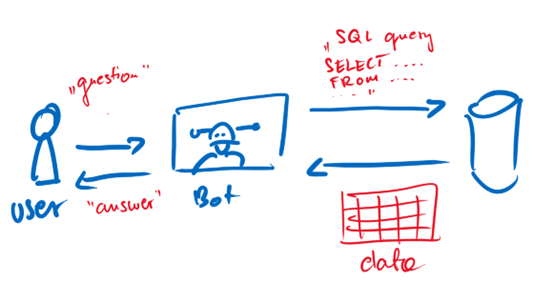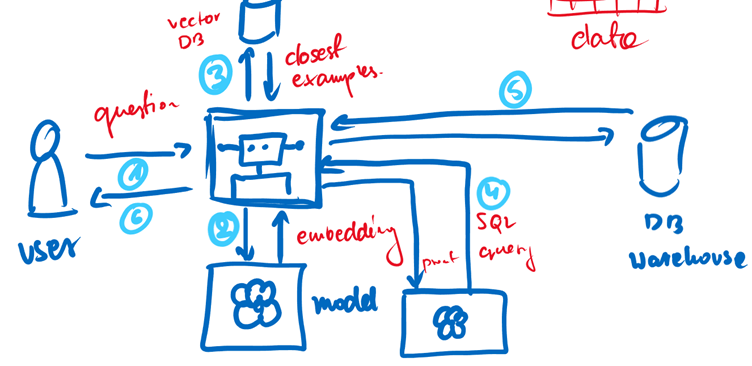Intro
Let’s consider a situation, where a marketing manager stumbling upon a valuable insight about a specific demographic. Yet, in the realm of traditional Business Intelligence (BI), if crucial data or metrics aren’t readily available on the dashboard, obtaining a custom report could take days. Such delays could mean missing out on a pivotal marketing opportunity. Enter AI data bots, poised to revolutionize BI by streamlining data exploration, making it faster, simpler, and more accessible for all.
Business intelligence (BI) has long been a valuable tool for organizations, offering data-driven insights to improve decision-making. Traditionally, however, information and insights are presented on a graphical dashboard. Those dashboards, when designed properly (read more on our approach to data UX), provide business users easy way to track pre-defined metrics and trends. However, accessing non-standard metrics or exploring data deeper required technical expertise and writing complex SQL queries by business users. Otherwise, business needed to wait long time (often a few weeks) for the IT department to implement the required metrics on the dashboard. This creates a bottleneck – valuable data sits locked away, waiting for someone with the right programming skills to unlock its potential.
The emergence of advanced natural language models, such as Large Language Models (LLM), has significantly altered the dynamics in the field of Business Intelligence (BI). With these innovative solutions, business users can now explore data in a much more intuitive, interactive, and accessible manner than ever before. LLMs enable data analysis based on ordinary natural language, eliminating the need for writing complex SQL queries or using advanced programming tools. As a result, business users can easily ask questions, draw conclusions, and obtain real-time answers, positively impacting the decision-making process and data utilization within organizations.
What are AI data bots?
AI data bots (also known as NL2SQL – Natural Language to SQL bots) are software solutions that lets you retrieve important information from your company’s data warehouse by asking questions in the same way you’d ask a colleague.. These are innovative tools that bridge the gap between traditional BI and the way we naturally interact with information. Instead of writing complex queries in a specialized language like SQL, using specialized developer tools, AI data bots allow you to ask questions about data using plain English in either dedicated conversational interface or for example MS Teams.
For instance, a sales manager could simply ask, “What were sales figures for each region in the last quarter?” The NL2SQL bot would then translate that question into the appropriate SQL query, retrieve the data from the database, and present it in a clear and understandable format – all without the manager needing to write a single line of code.

Under the hood, AI data bots leverage advancements in artificial intelligence in natural language processing (NLP) to understand the intent behind your questions. They can identify key elements like columns, tables, and aggregations (summary, average, count, etc…), and then translate them into the SQL query.
So how AI data bots actually work?
So how do these AI data bots work their magic? Let’s demystify it a little bit.
Is it as simple as just asking a proper question to the model to get the correct SQL query? Let’s break it down into a simple step-by-step process:
- First, user asks a question in plain language. This could be something like “What were our top-selling products last month?” or “Show me the average customer order value by region”. The AI data bot then takes center stage.
- It uses a large language model (LLM) to create an embedding – a numeric representation of a question asked. This representation holds the meaning of the question (its semantics), so you can compare it to other queries that are stored in the bot’s knowledge base with similar meanings.
- Then, the bot compares the embedding, with other embeddings stored in a knowledge base. The reason for that is to get few, similar examples of questions from the past (or prepared by the bot designers) and retrieve SQL queries that were generated for that similar asks. Those will be then used in the context of the main question.
- Using retrieved examples in the prompt context and LLM abilities to understand the key elements of user question the final SQL query is generated. This is called few-shot prompting – a very effective way to provide a general LLM model company with specific information.
- Using the generated SQL query bot then fetches the data from the database and presents it back to the user in a clear and user-friendly format, like a table or chart.
This entire process happens behind the scenes, allowing user to interact with the data in a way that feels natural and intuitive. From the user perspective it is a simple as asking the question and getting the final answer.

Benefits of AI data bots
Conversational interface for “talking” with the data in natural language is complementary to graphical interface provided by traditional BI dashboards. Where good dashboards provide insights and information at one glance, AI data bots enable further data exploration and asking non-predefined questions on-demand.
But AI data bots provide many more benefits for organizations:
- Empowering Business Users – Traditionally, accessing BI meant wrestling with complex queries and specialized languages. NL2SQL bots dismantle this barrier by empowering business users. They can now ask questions directly, using plain English they’re comfortable with.
- Improved Decision-Making – NL2SQL/NLQ bots are transforming decision-making within organizations. By enabling faster access to insights, they empower users at all levels to make data-driven choices. Imagine a sales director needing to adjust campaign strategies based on regional trends. Traditionally, waiting for reports could delay action. With NL2SQL/NLQ bots, they can get real-time insights and quickly adapt their approach. This fosters agility and ensures everyone has the data they need to make informed decisions that drive business success.
- Citizen Data Scientists – AI data bots democratize Business Intelligence by creating a new breed of “citizen data scientists.” Imagine a product manager with a hunch about purchase patterns. Previously, they might have been limited to pre-built reports. With NL2SQL/NLQ bots, they can ask targeted questions like “What products are frequently bought together?”
- Breaking Down Silos – NL2SQL bots also act as a bridge within organization. By allowing users across departments to ask questions of the same data source using plain language, they foster collaboration and break down information silos.
Conversational Analytics – an outlook into the future
Imagine that you can have an interactive conversation with your data, asking follow-up questions and refining your analysis as you go. The data bot could even suggest additional questions, that might be good to ask. What’s more, the bot could even suggest some interpretation of the insights that were retrieved from the data. This future of business intelligence is being shaped by advancements in conversational analytics, and AI data bots are at the forefront.
Currently, NL2SQL bots typically answer single, isolated questions. Conversational analytics takes this a step further, enabling a more natural dialogue. Instead of needing to formulate a properly worded query from the outset, you can ask an initial question and then refine it based on the answer.
For instance, you might start by asking, “What were our top-selling products last quarter?” The NL2SQL/NLQ bot would answer your question, perhaps presenting a chart. But the conversation doesn’t end there. You could then ask a follow-up question, like “How does this compare to the previous quarter?” The bot, leveraging its understanding of your previous query and the context of your conversation, would be able to adjust the data accordingly, showing you the sales trends over time.
Conversational analytics empowers a more iterative approach to data exploration. This back-and-forth dialogue allows users to progressively refine their understanding and uncover hidden insights within the data. Conversational analytics will to transform BI into a truly interactive experience, making data exploration more intuitive and efficient for everyone.
Conclusion
AI data bots are poised to revolutionize business intelligence (BI) by breaking down technical barriers and democratizing data access. No longer will users need to be SQL experts to unlock the power of their company’s data. These innovative tools empower everyone to ask questions in plain English, fostering a culture of data exploration across departments and experience levels.
This shift has the potential to unlock a new wave of data-driven decision-making within organizations. AI data bots are not here to replace traditional BI dashboards and tools, but rather to complement them by making data exploration more accessible and intuitive for a wider range of users. As NL2SQL bots continue to evolve, they hold the promise of transforming BI into a truly conversational experience, where everyone can have a dialogue with their data and gain deeper insights that drive business success.
Implementing modern AI-driven tools like AI data bots, even on a small scale, can offer a significant competitive advantage for your organization. Starting with a pilot deployment enables the development of essential competencies in utilizing these tools. As technology evolves, integrating them into your analytics processes becomes increasingly feasible. It’s important to note that other companies are already leveraging these solutions, potentially leading to a loss of competitiveness if action isn’t taken towards their adoption.
Would you like more information about this topic?
Complete the form below.


